SENSATION + PERCEPTION
1/101
Earn XP
Description and Tags
Name | Mastery | Learn | Test | Matching | Spaced |
|---|
No study sessions yet.
102 Terms
colour constancy
brain’s ability to recognize colour of an object as being the same even under different light conditions
sensation
process by which sensory organs detect environmental stimuli + convert them into electrical signals for the nervous system
stimulus
something that elicits a reaction from our sensory systems
transduction
transformation of sensory stimuli energy into neural impulses
perception
brain’s interpretation of these electrical signals to create an internal representation of the world
bottom-up processing
interpretation based on raw sensory data
top-down processing
interpretation based on prior experience, knowledge + expectations
pyschophysics
study of relationship between the physical qualities of stimuli (physics) and our mental experience of them (psyche)
absolute threshold
minimum amount of stimulus that can be detected > 50% of the time
liberal bias
low threshold for detecting a signal
sensitivity
ability to perceive and process information about the environment (inverse of the threshold value)
conservative bias
high threshold for detecting a signal
just-noticeable difference/difference threshold
smallest difference betwen two stimuli that c an be detected more than 50 % of the time
weber’s law
as stimuli increases, differences must become larger to be ditectable
weber’s fraction = minimum change in stimulus/stimulus
adaptation
stop noticing a stimulus that remains constant over time
vision
processing of light reflected from objects
visible light
type of electromagnetic radiation emitted by the sun, artificial light etc,, that can be detected by the eye
wavelength
distance between successive peaks
amplitude
height of wave
cornea
transparent tissue covering the front of eye, focuses light
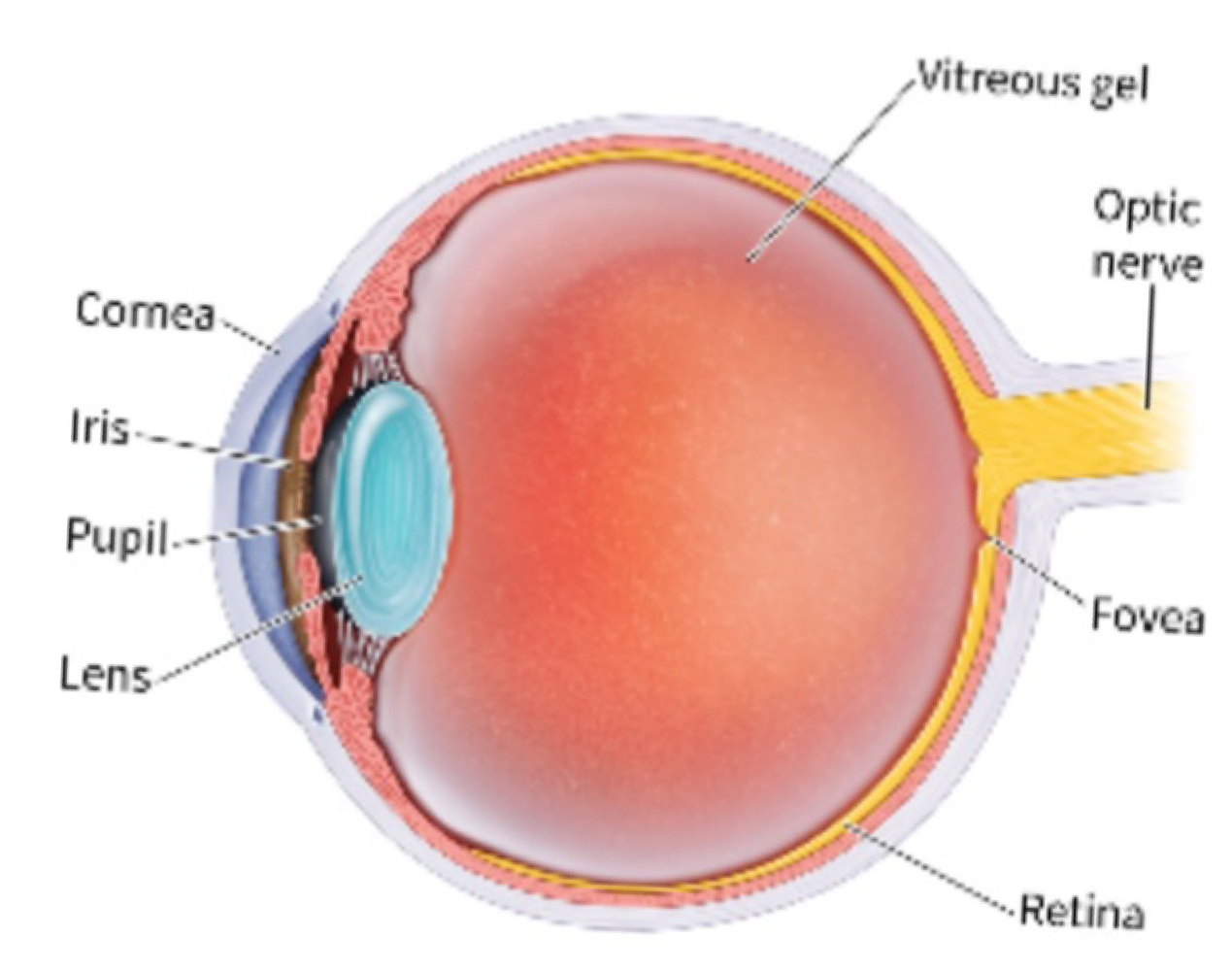
iris
opaque, colourful muscle encircling pupil
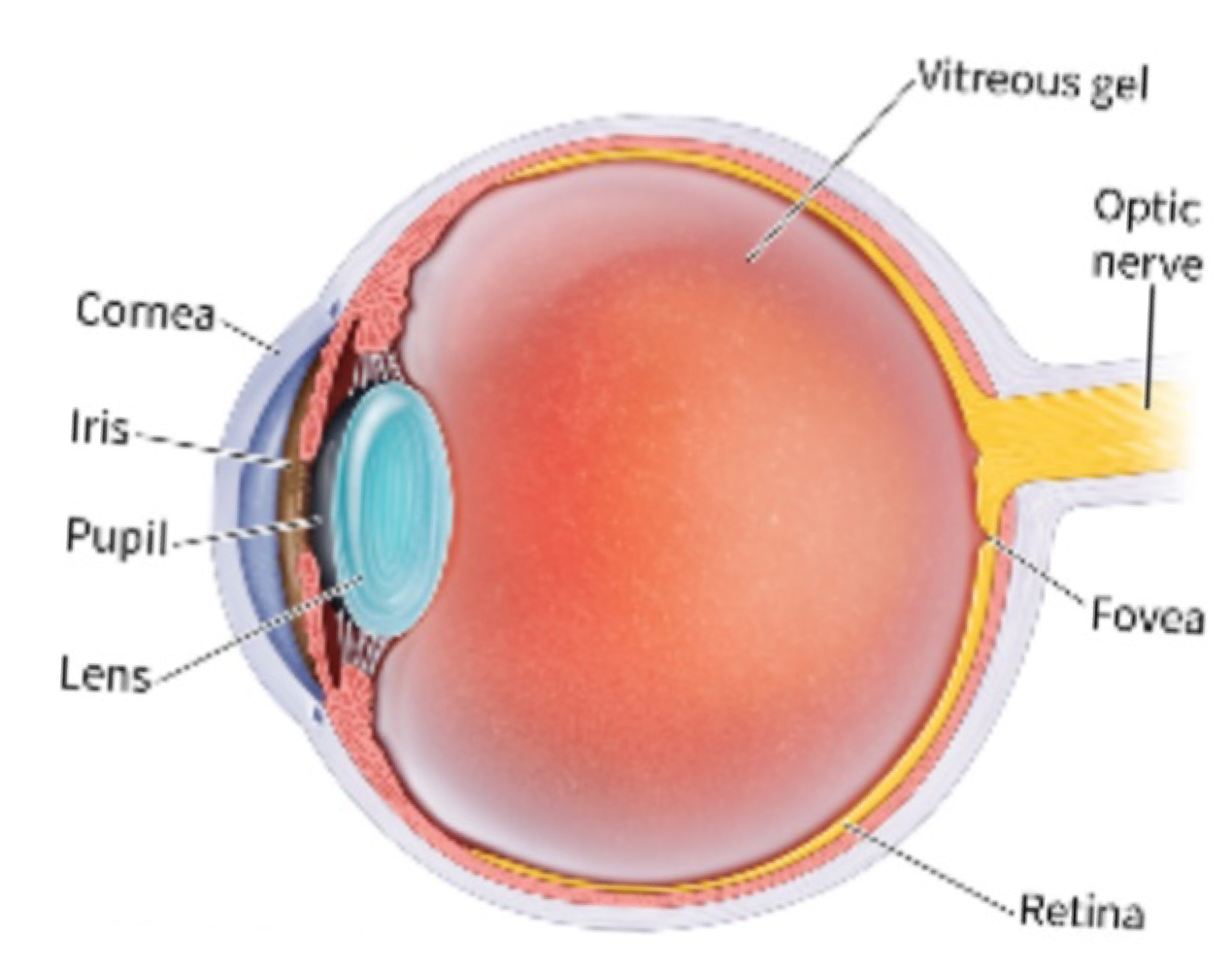
pupil
hole in the iris where light enters the eye

lens
membrane at front of the eye that focuses incoming light on the retina

accomodation
adjustments of the lens’ thickness by specialized muscles in order to change the degree to which it bends light
retina
surface in the back of the eye containing photoreceptors
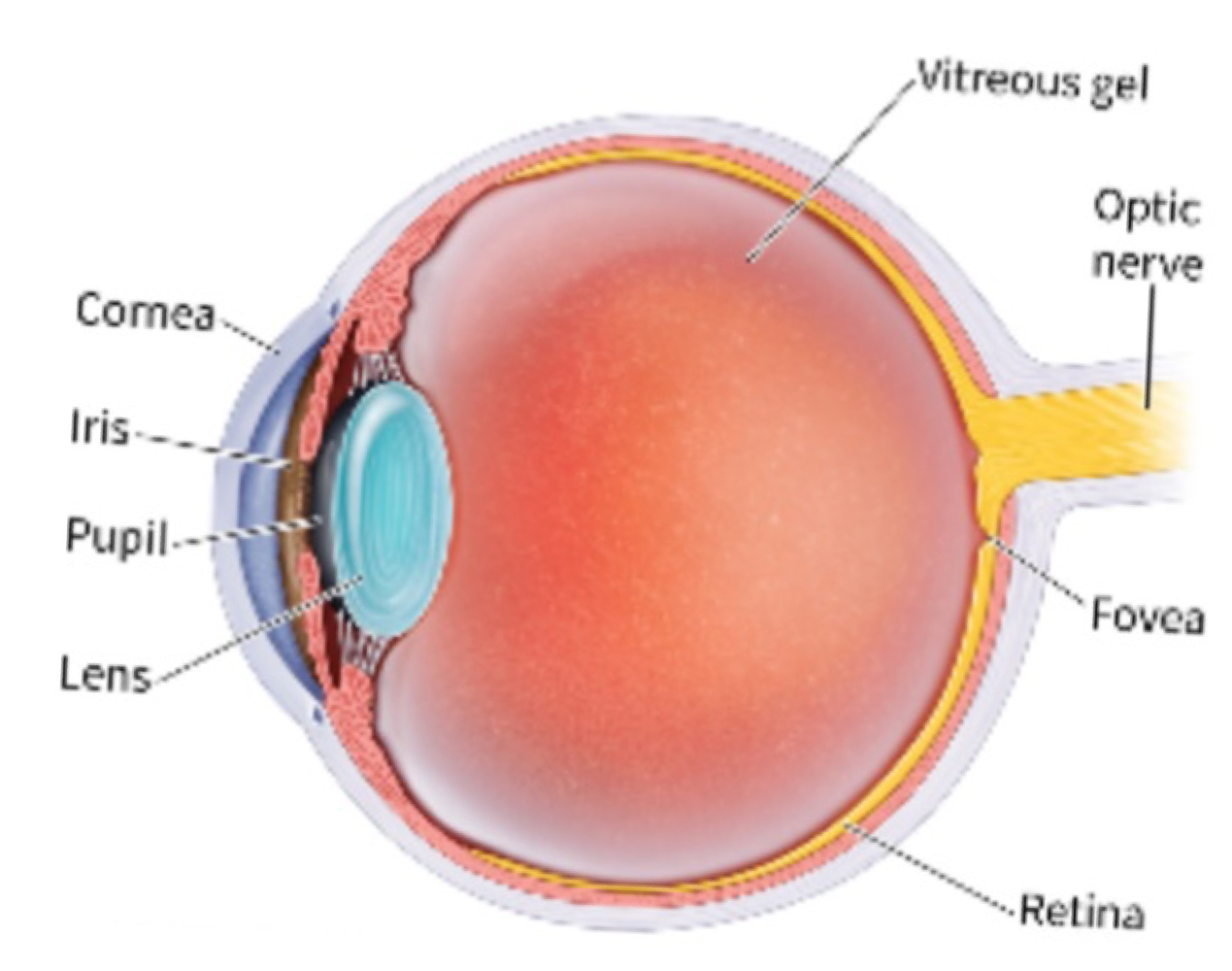
photoreceptors
receptor cells specialized for transducing light (rods + cones)
rod
photoreceptor cell that primarily supports nighttime vision
cone
photoreceptor cell that is responsible for high-resolution colour vision
visual transduction
when light reaches the photoreceptors + photo pigments undergo chemical reactions to generate electrical signals
photo pigments
light sensitive molecules
blind spot
area in the middle of the visual field where there are no photoreceptors and no information can be received
rods vs cones
rods all have same type of photopigment, cones have 3 options
rods contain rhodopsin
rod to cone ratea of 20:1 (cones are concentrated in fovea while rods are in central periphery)
cones have more direct connections to neural celsl; rods converge more
cones recieve more cortical representation
cones have higher acuity, wheras rods have higher sensitivity
rhodopsin
light-sensitive pigment that lets us see in the dark
fovea
small pit in centre of the retina that plays an essential role in our ability to see fine details and perceive color

trichromatic theory
3 types of cells work togehter to produce perception of colour
ganglion cells
cells in the retina that are organized in pairs that respond to opposing colours and receive input from cones
prosopagnosia
inability to recognize faces
feature detectors
specialized neurons that respond to specific attributes of visual stimuli
processes of higher-level vision
The brain processes and organizes the data it receives from the retina through hierarchical
series of steps of increasing complexity
Visual information travels along optic nerve to optic chiasm, where axons from each side of the retinas are diverted to corresponding side of the brain
Thalamus (relay station) passes information on to primary visual cortex
Image reconstructed in primary visual cortex
Visual association cortex combines incoming sensory inputs with prior knowledge & expectations
Additional processing in temporal lobe allows
you to recognize specific objects, like faces
ventral stream
processes ‘what’ information, responsible for recognizing objects + faces
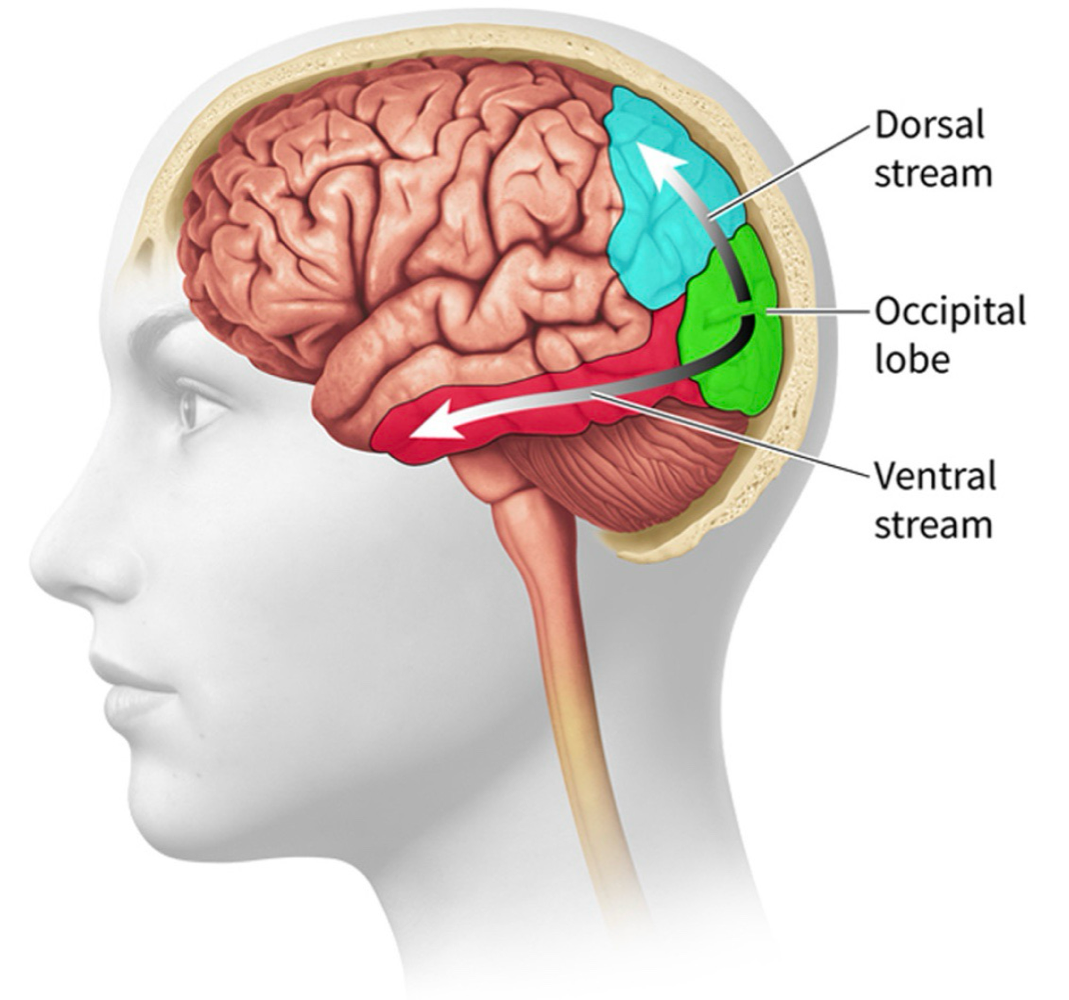
dorsal stream
processes ‘where’ information, responsible for determining location + the perception ofmovement

gestalt psychology
perspective that we perceive whole, organized patterns and objects
figure + ground
the automatic tendency to divide visual scenes into an object of main focus (figure) and ground (background)
depth perception
brain uses various cues to translate a 2-d image projected onto to the retina into 30d
binocular cues
depth information gathered from the separation between an individual’s two eyes
binocular disparity
cue for depth perception stemming from the slightly disparate views that two eyes have on an object or scene
monocular cues
depth information that can be gathered using just one eye
motion parallax
when you move your head, objects closer to you appear to move faster than objects farther away
linear perspective
parallel lines appear to converge in distance
interposition
nearby objects occlude more distant ones
relative height
objects further away appear closer to the horizon
relative size
objects further away appear smaller than nearby objects
size constancy
objects further away project a smaller image on the retina, but brain accounts for variation in retinal images + interprets it as a cue for depth
sound
waves of vibration in the form of mini collisions between adjacent molecules in a medium like air or liquids
frequency
number of cycles that occur per second, measured in Hertz (hz)
pitch
the highness or lowness of sound (determined by frequency, the greater the frequency the higher the pitch)
volume
the loudness of sound (determined by amplitude, the higher the amplitude the louder the sound)
pinna
captures and funnels soundwaves through auditory canal towards the middle ear
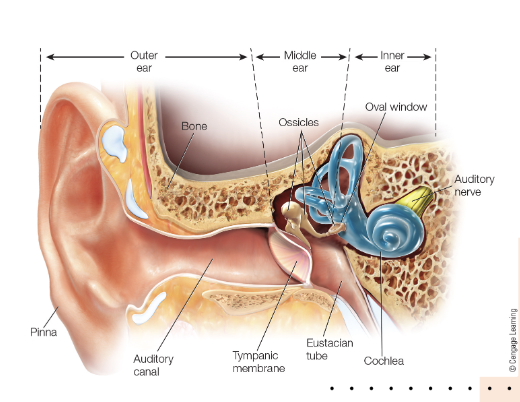
middle ear
contains the eardrum and the ossicles
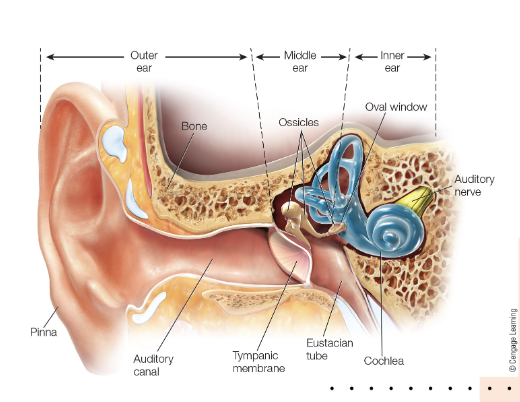
human ear
components that work together to collect, amplify + transduce vibrations into neural signals

ossicles
tiny bones located between two membranes, amplify vibrations of incoming soundwaves + protect inner ear from loud noises
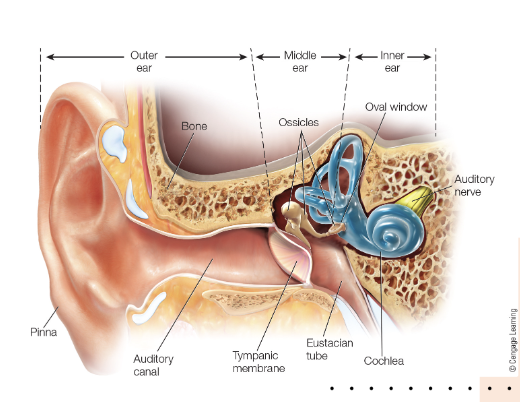
inner ear
contains the vestibular system + cochlea

basilar membrane
in the cochlea, contains specialized receptor cells for transducing vibrations transmitted into the inner ear into neural signals, occurs when hairlike auditory cilia bend in response to vibration, signal then carried along auditory nerve to the brain
place theory
theory proposing that different sound frequencies are processed at different parts of the basilar membrane, accounts for selective hearing loss
frequency theory
theory proposing that frequency of auditory neurons firing matches frequency of sound wave, for higher frequencies, groups of neurons alternate firing to match frequency
primary auditory cortex
contains place-frequency maps
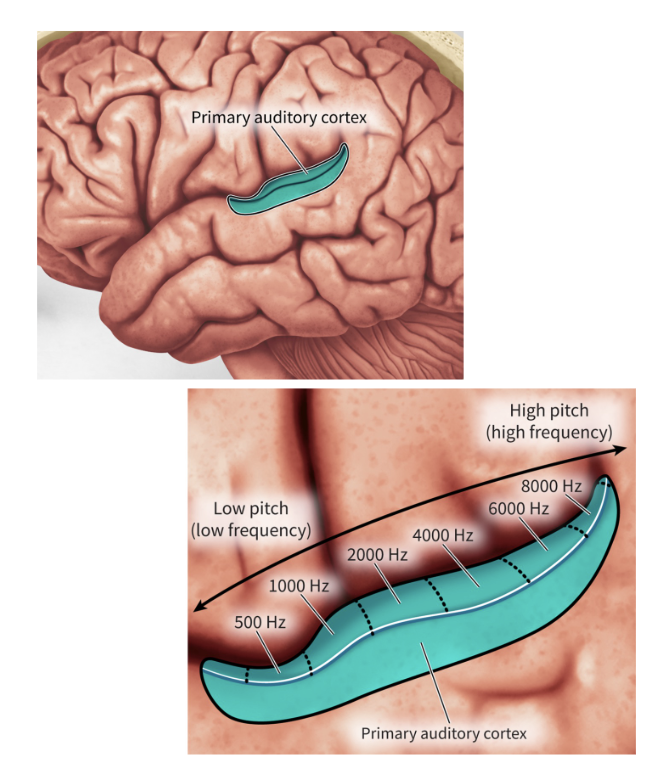
sound localization
brain compares information coming from each ear to determine relative timing + intensity
tactile sense
perception of touch
mechanoreceptors
sensory receptors that respond to mechanical stimulation (eg, pressure, touch, vibration, stretch)
myelinated mechanoreceptors allow for fine-grained discriminations
tactile agnosia
inability to recognize object by touch (caused by damage to association areas)
interoception
ability to perceive signals originating within the body
insula
part of the insular cortex, plays key role in processing bodies signals (interoception), imbues them with emotional and motivational significance
proprioception
sensory experience of the body’s position in space
proprioceptors
special receptors in muscles, tendons, joins that detect changes in muscle length, tension + joint position
vestibular system
system in the inner ear that helps maintain balance by detecting head movements and motion (information travels along auditory nerve to medulla + cerebellum then somatosensory cortex + primary motor cortex)
vestibulo-ocular reflex
reflex that helps stabilize gaze during head movements (signal moves from semicircular canals to the brainstem, which then coordinates eye muscles to move eyes in opposite direction of head )
olfaction
sense of smell (important for enhancement of taste, detection of hazards)
epithelium
mucous membrane in the nasal factory that contains olfactory cilia

olfactory cilia
olfactory receptor neurons

olfactory bulb
structure that recieves input from olfactory sensory neurons, responsible for basics processing + contains glomeruli
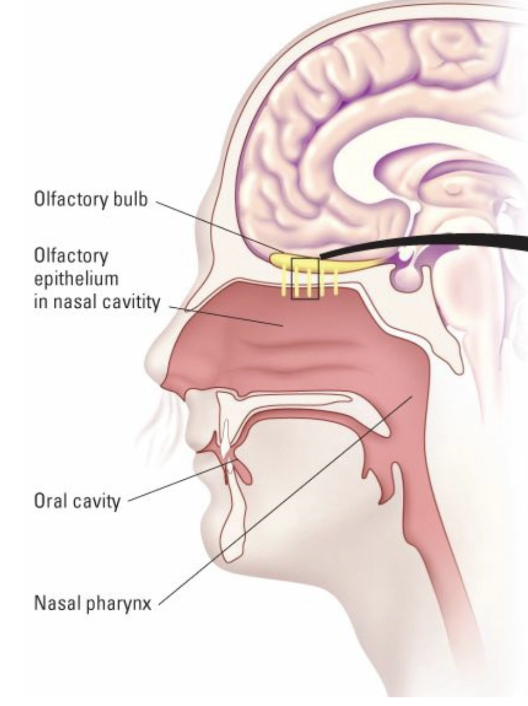
glomeruli
patters of activations that encode different odours
higher-level oflactory processing
infromation from olfactory bulb is sent to amygdala and hippocampus (parts of the limbic system) which allows us to make odour-memory connections
small → flavour
opening connecting back of mouth cavity w nasal cavity lets us smell substances that have entered the mouth
orbitofrontal cortex
part of olfcation association cortex, where smell and taste converge
gustation
sense of taste, taste receptors on the tongue correspond to 5 tastes (sweet, salty, sour, bitter, savoury/umami)
primary gustatory cortex
in the insula, sends connections to many cortical areas (, including orbitofrontal cortex, where neural signals for taste and smell are combined)
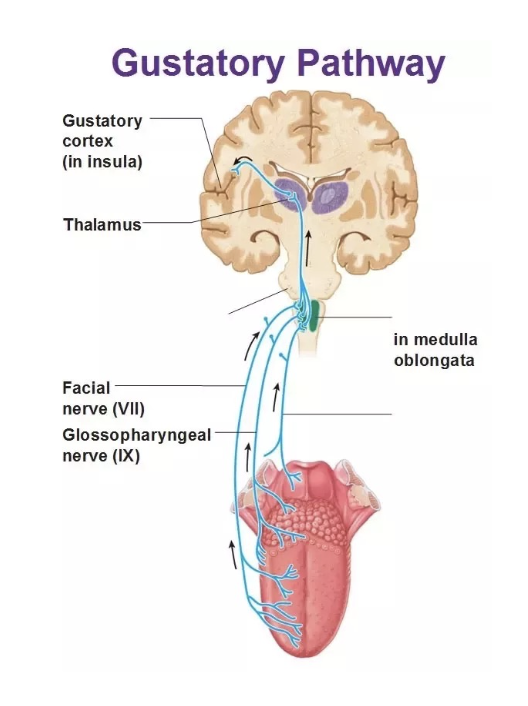
mcGurk effect
visual stimulus changes perception of sound (sight has dominance over other senses, particularly sound)
light/dark adaptation
rhodopsin (rod photochemical) breaks down and becomes inactive when exposed to bright light but regenerates in the dark
opponent-process theory
perceptual systems treat the visible spectrum as a circle, where the two ends meet (therefore cannot see ‘reddish-green‘ or ‘yellowish-blue‘ as the colours cancel each other out because ganglion cells are excited by one or the other)
afterimages
image that appears in eyes after a period of exposure to the original image (occurs because cones get fatigued after looking at one colour for too long and the ganglion cells begin to send weaker signals corresponding to that, then the opposing cells fire, sending signals that cause the perception of the opposing colour)
visual association cortex
combines incoming sensory inputs w prior knowledge + expectations
visual agnosia
inability to recognize visually presented objects
gestalt principles
identified principles that the visual system follows to organize incoming data and recognize objects
proximity
simalarity
closure
good continuation

reversible figures
demonstrate how our overall perception of an object may differ from the elements from which its perception is derived
illusory contours
how the whole affects perception of parts, we let our prior expectations affect our perception of the shape
perceptual stability
tendency to perceive an object you’re familiar with as having constant shape, size, and brightness despite stimuli changes
evolutionary purpose of taste
promotes increased nutrition
prevents intake of poison
rubber hand illusion
experimenter hides your hand and places rubber hand on table
experimenter strokes your hidden hand and the fake rubber hand at the same time with a dual stick instrument
the rubber hand seems to become your own and feel the stroking sensation
vision tells your somatosensory cortex to shift its sensation to an area where receptors do not even exist
primary somatosensory cortex
cortex dedicated to sense of touch
primary sensory area
first cortical region in each lobe to recieve signals from its associated sensory nerves